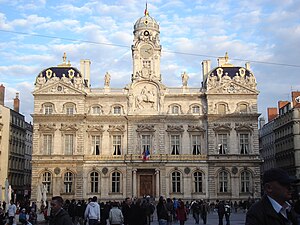1st arrondissement (Lyon)
|
1st arrondissement (L'hôtel de ville.) Arrondissement municipal of Lyon |
|
|---|---|
| Coordinates | 45 ° 46'7 " N , 4 ° 50'1" E |
| surface | 1.51 km² |
| Residents | 29,352 (Jan. 1, 2017) |
| Population density | 19,438 inhabitants / km² |
| INSEE code | 69381 |
| Post Code | 69001 |
| structure | |
| Quarters | |
The 1st arrondissement is one of the nine arrondissements of Lyon (city district). It lies on the slope of the Croix-Rousse and on the northern side of the peninsula formed by the confluence of the Saône and Rhône rivers.
history
The hill Saint-Sébastien was formerly part of the Franc-Lyonnais area and was incorporated into the city of Lyon in 1512. This is the date that Louis XII. ordered the construction of a fortress to defend Lyons on the hill.
The 1st arrondissement is one of the five created by presidential decree of March 24, 1852.
geography
The 1st arrondissement is located in the center of the peninsula and is the smallest of all arrondissements. The bars and pubs around Place des Terreaux make the district the liveliest in Lyon.
The 1st arrondissement includes the following quarters:
- Terreaux
- Pentes de la Croix-Rousse
- Les Chartreux
- Croix-Paquet
- Saint Vincent
Special locations:
- Place des Terreaux
- Montée de la Grande-Côte
- Le jardin des Chartreux
- Place de la Comédie
- Rue de la République
- Place Louis Pradel
- Quai Saint-Vincent
- Quai de la Pêcherie
Demographics
| year | 1999 | 2006 | 2009 | 2011 | 2014 |
|---|---|---|---|---|---|
| Residents | 26,861 | 28.210 | 28,268 | 28,932 | 29,539 |
In 2013 the population density was 19,413 inh / km².
administration
Nathalie Perrin-Gilbert is the city's mayor.
Buildings
- Hôtel de ville de Lyon (City Hall)
- Le Palais St Pierre, the Musée des Beaux-Arts
- L ' Opera de Lyon
- Le Patineur by César
- Lyon amphitheater
- La Fresque des Lyonnais
Public facilities
- Hotel de Ville
- Lycée de la Martinière
- Salle Rameau
- Halles de la Martinière
- City hall of the 1st arrondissement, place Sathonay
- Maison Ahmadou Kourouma
Transport links
- Métro Lyon A , Station Hôtel de Ville - Louis Pradel
- Métro Lyon C , Station Hôtel de Ville - Louis Pradel, Croix-Paquet
Culture
- Musée des beaux-arts
- Opéra de Lyon
- There are numerous café-theaters on the slopes of the Croix-Rousse
particularities
- The population consists of mixed social classes, half of which live in so-called ZUS . The arrondissement is also increasingly valued as the city of the " Bobo ".
- A strong gay community has settled here since 1980. This is particularly the case around the opera district and the Croix-Rousse hills. The arrondissement has around 20 shops (bar, boutique, restaurant) and several associations (LGBT) tailored to this clientele. In 2009, Têtu magazine named Lyon the best “gay-friendly” city in France (after Paris).
- The district is the premier address for a thriving nightlife. There are many bars and pubs, especially behind the Terreaux square in the “ Quartier Sainte-Catherine ” district.
More information
Individual evidence
- ↑ Nathalie Perrin Gilbert. In: mairie1.lyon.fr, accessed on August 21, 2018.
- ↑ When Z ones U rbaines S ensibles (German: sensitive neighborhoods) are called in France neighborhoods where the proportion of poor and / or non-French population predominates.
- ^ Plan gay. (No longer available online.) In: gayinlyon.com. GayinLyon.com, September 20, 2017, archived from the original on September 20, 2017 ; accessed on August 21, 2018 (in French, navigation no longer possible).
- ^ FC: Lyon, première au palmarès des "villes gay-friendly". (No longer available online.) In: 20minutes.fr. 20 minutes , February 19, 2009, archived from the original on July 16, 2012 ; accessed on August 21, 2018 (French).
- ^ Rénovation de la Croix-Rousse à la Lyon. In: dailymotion.com. 2009, Retrieved August 21, 2018 (1:52 min.).




